The AMD Radeon RX 5500 XT Review, Feat. Sapphire Pulse: Navi For 1080p
by Ryan Smith on December 12, 2019 9:00 AM ESTMeet the Sapphire Pulse Radeon RX 5500 XT
As I mentioned earlier in the article, while AMD does have a reference card, they aren’t going to be releasing it to retail. So instead, today’s launch is all about partner cards. To that end, AMD has sampled us with both the 8GB and 4GB versions of Sapphire’s Pulse RX 5500 XT. Sapphire’s card is a pretty good example of what to expect for basic (at-MSRP) RX 5500 XT cards, offering a solid build quality, but otherwise being pretty close to reference specifications.
| Radeon RX 5500 XT Card Comparison | ||||
| Radeon RX 5500 XT (Reference Specification) |
Sapphire Pulse RX 5500 XT (Default/Perf Mode) |
|||
| Base Clock | 1607MHz | 1607MHz | ||
| Game Clock | 1717MHz | 1737MHz | ||
| Boost Clock | 1845MHz | 1845MHz | ||
| Memory Clock | 14Gbps GDDR6 | 14Gbps GDDR6 | ||
| VRAM | 8GB | 8GB | ||
| GPU Power Limit | 120W | 135W | ||
| Length | N/A | 9.15-inches | ||
| Width | N/A | 2-Slot | ||
| Cooler Type | N/A | Open Air, Dual Fan | ||
| Price | $199 | $209 | ||
Sapphire has several sub-brands of cards, including the Nitro and the Pulse. Whereas the former are their higher-priced factory overclocked cards, the Pulse cards are more straightforward. For their RX 5500 XT cards, Sapphire does ship them with a higher than reference GPU power limit – leading to a 20MHz higher game clock rating – but the actual GPU base and boost clockspeeds remain unchanged. This goes for both the 4GB and 8GB cards, which aside from their memory capacities are identical in both build and specifications.
At a high level, the Sapphire Pulse RX 5500 XT is a pretty typical design for a 150 Watt(ish) card. Sapphire has gone with a dual slot, dual fan open air cooled design, which is more than enough to keep up with Navi 14.
In fact, once we break out the rulers and really dig into the Sapphire Pulse, it becomes increasingly clear that Sapphire may have very well overbuilt the card. The card’s cooling system and shroud is longer than the PCB itself – it’s the board that’s bolted to the cooler, and not the other way around. Similarly, Sapphire has gone for a taller than normal design as well, allowing them to fit a larger heatsink and fans than we’d otherwise see with cards that are built exactly to PCIe spec. The resulting card is quite sizable, measuring about 9.15-inches long, and 4.25-inches from the bottom of the PCB to the top of the shroud.
The payoff for this oversized design is that Sapphire can use larger, lower RPM fans to minimize the fan noise. The Pulse 5500 XT packs 2 95mm fans, which in our testing never got past 1100 RPM. And even then, the card supports zero fan speed idle, so the fans aren’t even on until the card is running a real workload and starts warming up. The net result is that the already quiet card is completely silent when it’s idling.
Meanwhile beneath the fans is a similarly oversized heatsink, which runs basically the entire length and height of the board. A trio of heatpipes runs from the core to various points on the heatsink, helping to draw heat away from the GPU and thermal pad-attached GDDR6 memory. The fins are arranged horizontally, so the card tends to push air out via its I/O bracket as well as towards the front of a system. The card also comes with a metal backplate – no doubt needed to hold the oversized cooler together – with some venting that allows air to flow through the heatsink and out the back of the card.
Overall, Sapphire offers two BIOSes for the card, which are selectable via a switch on the top. The default BIOS is Sapphire’s performance BIOS, which has the GPU power limit increased to 135 Watts. As we’ll see in our benchmarks, the net performance impact of this is not very substantial, but it does allow the card to average slightly higher clockspeeds. Meanwhile the second BIOS is rigged for quiet operation, bringing the card back down to a GPU power limit of 120W.
Speaking of power, the card relies on an 8-pin external PCIe power cable as well as PCIe slot power for its electricity needs. From a practical perspective this seems overprovisioned for a card that shouldn’t pass 150W for the entire board – so a 6 pin connector should work just fine here – but with Sapphire’s higher power limit bringing the card right up to that 150W threshold, I’m not surprised to see them playing it safe.
While we're on the subject of PCIe, it’s worth mentioning quickly that while the Sapphire Pulse is physically a PCIe x16 card, electrically it’s only a x8 card. A traditional cost-optimization move for AMD, they have only given the underlying Navi 14 GPU 8 PCIe lanes, so while the card uses a full length x16 connector, it only actually has 8 lanes to work with. This won’t present a performance problem for the card on PCIe 3.0 systems, and better still as Navi offers PCIe 4.0 connectivity, it means those 8 lanes are twice as fast when paired with a PCIe 4.0 host – where coincidentally enough, AMD’s Ryzen processors are the only game in town right now.
Finally for hardware features, for display I/O we’re looking at a pretty typical quad port setup. Sapphire has equipped the card with 3x DisplayPort 1.4 outputs, as well as an HDMI 2.0b output. With daisy chaining or MST splitters, it’s possible to drive up to 5 monitors from the card.
As for software, Sapphire ships their cards with their TriXX monitoring and overclocking software. It’s been some number of years since we’ve last taken a look at TriXX, and while the basic functionality has remained largely unchanged, the most recent iteration of the software comes with a very streamlined and functional UI. Overall as far as overclocking goes, TriXX ultimately just hooks into AMD’s drivers, so while it’s capable, it’s no more capable than AMD’s constantly improving Radeon Software.
The one area where Sapphire is still able to stand apart from AMD, however, is with their TriXX Boost feature. Not to be confused with the somewhat similar Radeon Boost feature in AMD’s drivers, TriXX Boost is Sapphire’s take on resolution scaling. The software combines custom resolution creation with GPU resolution scaling controls, essentially allowing a user to create a lower resolution and engage GPU resolution scaling all in a single go. The basic idea being to make it super easy to create a slightly lower resolution (.e.g. 1632x918) for better performance, and then having the GPU scale it back up to the full resolution of the monitor. The impact on image quality is as expected, and while it’s nothing that can’t technically already be done with AMD’s software, Sapphire has put a nice UI in front of it.


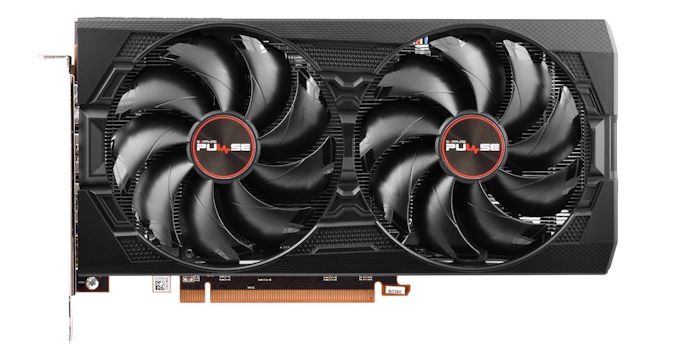
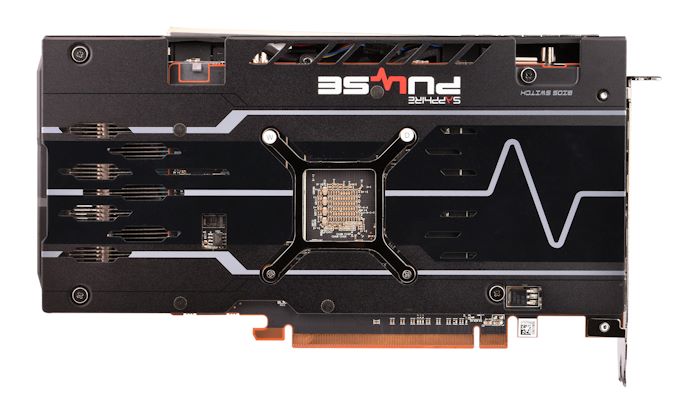
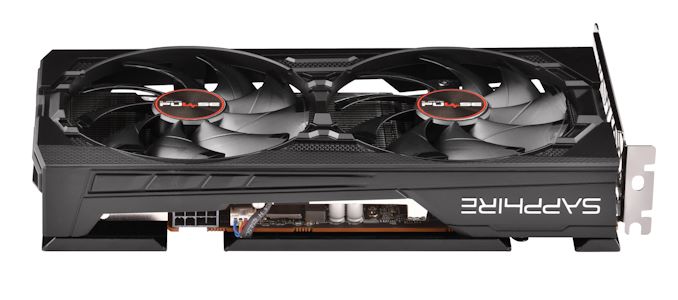
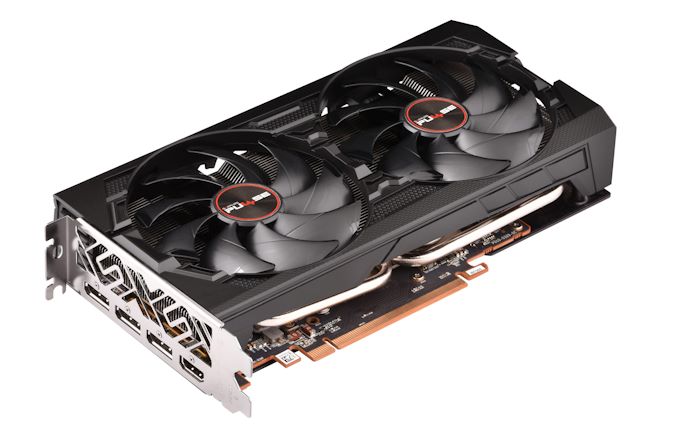
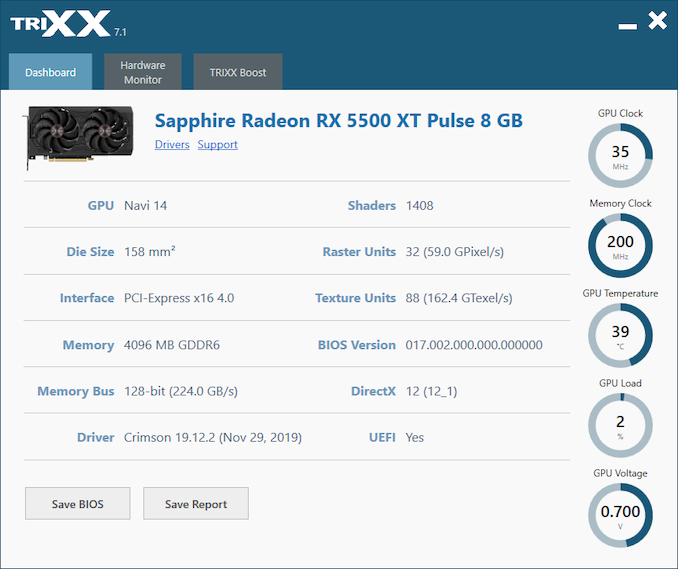
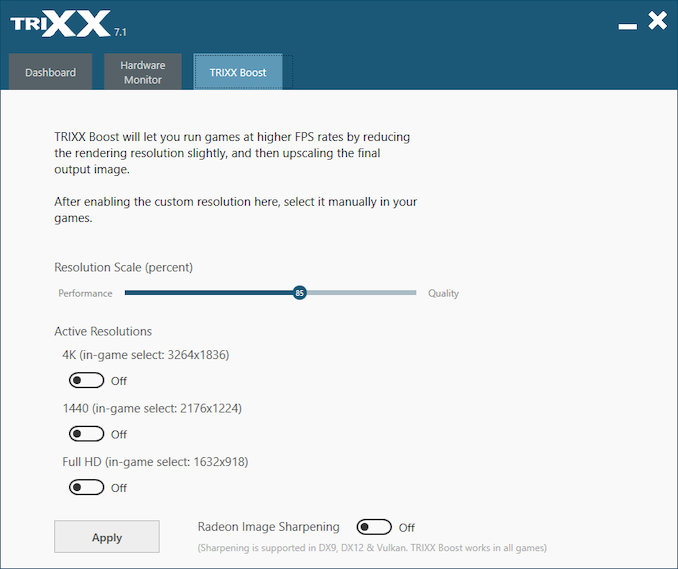








97 Comments
View All Comments
Korguz - Friday, December 20, 2019 - link
and nvidia will price most of their cards out of reach of most people.. like a large chuck of then are now.... do they need to charge that ?? probably not.. but they do... cause they can.. just like intel before zen...Kangal - Friday, December 20, 2019 - link
Not quite.Before, in the early 2000-2005 period the Internet was not as accessible and pronounced as it is today. And to add to that, when it came to "perception" things like marketing were very effective. So despite AMD producing some of the best CPUs and GPUs at the time, they weren't winning. Intel and Nvidia had the mindshare, thanks to their large marketing departments.
Now?
There's Facebook and YouTube. Information is much more accessible, anyone can find more details about a product from more trusted third-party professionals. And on top of that, the past few years has changed the public's mindshare about AMD. They're now seen as the better CPU company, so that trickle downs to their perception of GPUs as well. It is no longer a "poor mans Nvidia".
So what am I saying?
The more things change, the more they stay the same. The market will always have winners and losers. However, this time AMD is under new management and heading a new direction, and they have seized a real opportunity to turn things around. That might mean AMD only releasing a few cards, and instead focusing their attention to things that make money: servers and consoles. I'm fine with that, and if things kind of sour, well it was the (sheep) public's fault for allowing the monopoly to arise by not being more critical and skeptical (think pre-1950's attitude). However, I should also add that just because there is a monopoly does not mean the market isn't healthy or competitive or that it's bad for the consumer; it is likely to be the case but not a certainty.
Korguz - Friday, December 20, 2019 - link
nvidia had the mindshare.. but intel has its bribes and threats....either way.. unless amd can make a zen2 equivalent for radeon, nvidia will still over charge and price some of their cards out of reach of most people, like they already have done
Gemuk - Thursday, December 12, 2019 - link
I'd argue that it wasn't AMD selling RX 570 and RX 580 for cheap that has distorted the market, rather it was the consumer's acceptance of the higher pricing across the board. Price/perf needle has barely moved up after three years. It is the new norm. We're never going back to those days, are we?Yojimbo - Thursday, December 12, 2019 - link
Price/performance has moved up since 3 years ago. 3 years ago a 1060 cost about what a 1660 Ti costs now, and a 1660 Ti is about 36% faster than a 1060. You are getting over 30% increase in performance per price, even if you throw out what happened to 1060 prices because of the crypto craze and spike in DRAM prices. The gain in performance per dollar from the 960 to the 1060 was about 44%. So it's lesser this generation but I don't think the difference qualifies as "barely moved up" and you can't take one example and call it a trend. As for the RTX cards, of course with NVIDIA taking up die space on new features that don't go into price/performance calculations there is going to be a drag on the numbers that get spit out.AMD were selling the 570 and 580 for cheap because they had a bunch of them in inventory from the crypto hangover and they needed to get as much revenue for them as they could. If it took too long they would lose more value and they'd have to delay the 5500.
Alistair - Thursday, December 12, 2019 - link
you mean 1660 super is the same price as the 1060, the 1660 ti is still more expensive than the old 1060 from years agojabbadap - Thursday, December 12, 2019 - link
gtx1060 FE 6GB msrp was $299 same as gtx1660ti. While gtx 1060 6GB has "msrp" of $250, finding AIB sku priced as such was near to non-existent. Norm was $299 and more like gtx1660tis.1660 Super is $229, which is lower than any official price point nvidia gave to gtx1060 6GB cards.
HardwareDufus - Thursday, December 12, 2019 - link
Had one of my 24" 1920x1200 monitors fail the other day, and the other has a few lines. Therefore, I purchased 2 32" 4K monitors. Should arrive in days.Thinking about purchasing a discreet video card as my current I7-3770K with its IGP won't drive these new moniros to 4K resolutions.
I don't game, so I would imagine I'd received satisfactory performance with an inexpensive 5500XT card to drive both these monitors at 4K for really good size/readability of text?
Comments?
haukionkannel - Thursday, December 12, 2019 - link
For that usage... sure. But no Gaming unles you use 50% scaling. With 50% scaling and amd sharpening, even Gaming is good.Zoomer - Saturday, December 21, 2019 - link
Don't need sharpening with 50% scaling. Pixels will just be 4 times as big and map perfectly.